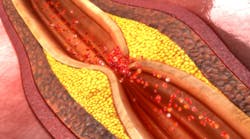Periodontal disease and atherosclerosis: Strengthening the oral-systemic link
A recent study in the medical journal Anaerobe investigated the link between eight periodontal pathogens and their virulence genes to atheromatous plaques in patients with ischemic heart disease. This study further strengthens the association between periodontal disease and atherosclerosis.
A RECENTLY PUBLISHED STUDY IN THE MEDICAL JOURNAL, Anaerobe, investigated the link between the presence of eight periodontal pathogens and their virulence genes to atheromatous plaques in patients with ischemic heart disease. (1)Many studies have looked at this link; however, the previous studies were commonly limited to the mere presence of oral bacteria.
This study looked at the bacteria and the bacterial genetic coding for virulence factors. The significance of inclusion of the virulence genes in this study is that it adds an additional level of credibility to the conclusions and insight into the mechanisms involved in the association between the bacteria and atheromatous plaques.
Subgingival and atheromatous plaque samples were obtained from 65 ischemic heart disease patients. The samples that were positive for the bacterial species Porphyromonas gingivalis (P. gingivalis), Treponema denticola (T. denticola), and Tannerella forsythia (T. forsythia) were screened for virulence genes. Two control groups consisted of 59 chronic periodontitis patients without systemic disease and 100 healthy subjects without periodontal disease or systemic diseases.
The results revealed significant odds and risk ratios to atherosclerosis for P. gingivalis, T. forsythia, T. denticola, and Prevotella nigrescens (P. nigrescens). Also revealed in the results was that among the virulence genes, significance to atherosclerosis was observed for specific serotypes of P. gingivalis and T. forsythia. The authors concluded: “The results of this study strongly correlate periodontal bacterial co-occurrence and periodontal bacterial adhesion factor to atherosclerosis.”
It is interesting to note that as technology advances, research advances. The ability to examine the bacterial virulence genes was not available a relatively short time ago. Also notable is the strength of the correlation between the bacteria and atherosclerosis. If the bacterial virulence genes were not included in the study, the presence of bacteria in atheromatous plaques could be coincidental. This study did not conclude that the bacteria were causal, as other studies have, but it does add another piece to the puzzle, which is complete enough at this point to see the image on the front of the box.
Reference
1. Mahalakshmi K, Krishnan P, Arumugam SB. Association of periodontopathic anaerobic bacterial co-occurrence to atherosclerosis—A cross-sectional study. Anaerobe. 2017;44:66-72. doi: 10.1016/j.anaerobe.2017.02.003.
For more from Dr. Nagelberg about 'Making the Oral-Systemic Connection,' click here.
For the most current dental headlines, click here.
About the Author
Richard H. Nagelberg, DDS
Richard H. Nagelberg, DDS, has practiced general dentistry in suburban Philadelphia for more than 30 years. He has served on many advisory boards and as a consultant and key opinion leader for a variety of companies and organizations. Dr. Nagelberg is the Director of Medical Affairs at OraPharma, a division of Bausch Health US, LLC. His practice and other professional activities are centered on the impact dental professionals have beyond the oral cavity. Contact Dr. Nagelberg at [email protected].
Updated May 2022


